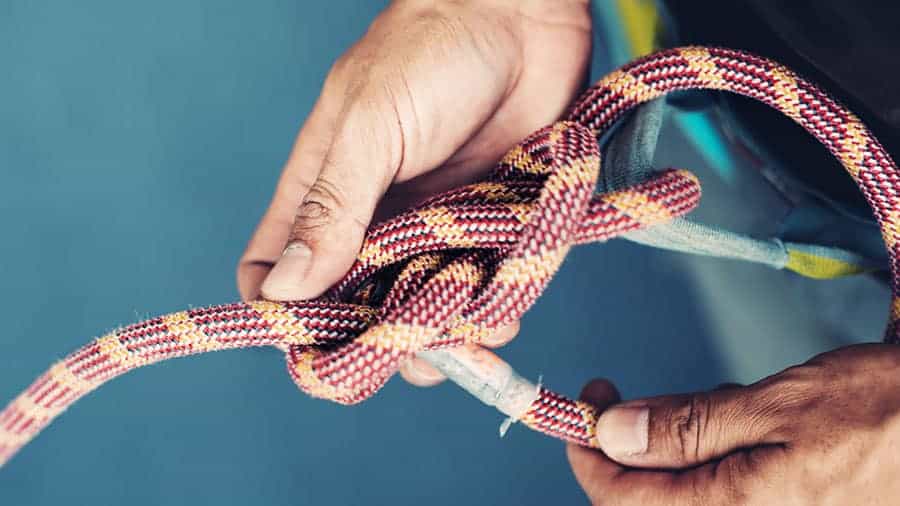Whether you’re preparing to purchase a rope or you have a rope and are wondering if how you should be taking care of it, you probably have a few questions about extending its life and how to keep it clean and last as long as possible.
When I got my first rope I was underwhelmed by the information online and it seemed like no one was talking about how to take care of your rope. Now it seems that there are plenty of articles out there but a lot of them seem to contradict each other.
With all of the confusion, I decided to find out what the rope manufacturers recommended for rope care and now I’m putting this article together so you can have a reliable source for what to do with your gear according to the companies that made it.
Using Your Rope
Now that you have a rope, there are a few things that you should consider when using it. Below are a few tips for using your rope and ways to ensure that it stays at its best while you are using it.
Fact:
Keeping your rope on a tarp while climbing will extend its life compared to dropping rope directly into the dirt.
Dirt and grime can eventually make the rope difficult to use, and thus keeping it clean will help extend its life. A clean rope will also make it go through belay devices smoother, which is essential for your safety and ease of use.
Myth:
Dry ropes can handle whatever kind of weather it is exposed to.
Even though dry ropes are treated so that it can handle soggier conditions, just like any other type of rope, UV exposure and mud can eventually ruin it. For this reason, don’t leave your rope out in the sun or in the rain/mud between climbs. Put it away.
Quick Tips For Using Your Rope:
- When out on the crag, avoid putting the rope directly on the ground. Try to keep it on a tarp or in a bag.
- Don’t walk on the rope
- Alternate the ends of the rope that you tie into on each pitch to avoid creating twists
- Avoid fast descents. Descending to fast on a rope will heat and sheath the rope, accelerating wear. In addition, if you descend too quickly, it can heat up the rappel device, which can get hot enough to melt the nylon fibers of the rope.
- Protect the rope from abrasions (for example, if the anchors are on top of the cliffside and the rope rubs against the mountainside) by adding a Protect Catapillar or Roll Module
Storage
Fact:
Rinsing off any salty water and then allowing your rope to dry before storing is a great way to ensure you get the most life out of your rope.
Salty water can damage your rope and that is why it is important to remove it before storing it. Leaving salt on the rope and then storing it for a long period of time can erode the rope and make it less reliable.
Myth:
Storing your rope in a wound and tied fashion is good for the rope.
Storing your rope in an uncoiled manner in the bag will actually help it last longer and prevent kinks from building in your rope.
Quick Tips For
- Never leave rope outside in the weather/sun
- Pay attention to your equipment’s possible proximity to gas cans, car batteries, or cleaners (risk of leaking).
- If your rope comes in contact with any chemical products, hare or corrosive substances (e.g. acids), retire your rope
- Store your rope in a well-ventilated area
- Avoid storing your rope in moist or damp areas that may develop mold
- For long-distance travel, beware of moisture in containers during transit, in ports or airports and especially in salty environments.
Rope Maintenance and Cleaning
Fact:
You should clean your rope at least once per year. Cleaning your rope at least once per year can help it last longer and function the way it needs to.
Myth:
You should never wash your rope in a washing machine.
To my surprise, a few rope making companies suggest that if you need to, you can use a washing machine, on special settings, to clean your rope.
According to Petzl, you can wash your rope in a washing machine. Choose the 30 °C delicate synthetic setting, without a spin cycle. Air-dry the rope (do not dry in the sun and do not store wet)
Quick Facts About Rope Maintenance and Cleaning
- Keep your rope clean. Any mud or wet sand on the rope can cause issues with ascenders, descenders and connectors.
- If you use your rope in areas that have a lot of sand or if it gets soaked in saltwater, remember to rinse the rope with water after use.
- When washing your rope by hand, only use hand or face soap in a tub of warm water. You can also use rope cleaner in warm water. Then rinse it off All other cleaning products, for example, solvents, stain removers, degreasers, etc. are too strong and are incompatible with nylon.
- Do not use a high-pressure water sprayer to clean your rope
Cutting Rope
Fact:
Buying rope in a spool and then cutting it to size is much less expensive than buying multiple ropes at the intended size.
There really is no surprise here but if you want multiple ropes at different sizes for the different height climbs that you do, this might be a really great option for you.
Myth:
Rope loses its integrity after being cut.
Though abrasions do ruin the integrity of your rope, cutting through it (intentionally) doesn’t as long as it is done correctly. This makes buying a spool of rope much more valuable if you know how to do it.
Quick Tips For Cutting Your Rope
Please note that this is not a guide for cutting your rope. Please see instructions from manufactures for recommended tools and processes.
- If you need to cut the rope, use a hot knife to make a neat and clean cut
- Ensure that if you cut the rope off of a reel or plan to use both pieces of rope, ensure that all of the appropriate information is still visible on the rope. You can do this by adding a label or adhesive tape with the diameter, length of rope and use of heat-shrink sheathing to protect the label.
More Buyer’s Guides:
- The Top 5 Crash Pads For Bouldering: How To Decide Which Is Best
- Diy Hangboard With Jugs And Edges For Less Than $15
- 6 Of The Best Belay Devices For Beginner Climbers
- The Best 11 Climbing Shoes Under $100
- Climbing Chalk: Chunky Vs. Fine
- The Best Chalk For Climbing And Bouldering
- Rock Climbing Starter Kits For Beginners Compared
- Liquid Chalk Vs. Dry Chalk For Bouldering (Hint: Dry Chalk Is Better)
- Top 5 Gear You Need In Your Climbing Pack For The Best Experience
- What To Wear While Bouldering
- Should You Upgrade To An Assisted-Braking Belay Device?
- Everything You Need To Know About Climbing Chalk
- 37 Things Serious Climbers Bring With Them To The Mountains
- Clothing For Climbing In The Gym – What Should You Wear?
- Can You Climb Without Chalk?
- How Tight Climbing Shoes Should Fit For The Best Performance
- Harnesses For Rappeling
- My Favorite Harness For Climbing
- What You Should Wear While Climbing
- What Affects How Climbing Shoes Fit?
- How To Clean Your Grigri
- How To Care For Your Climbing Rope



